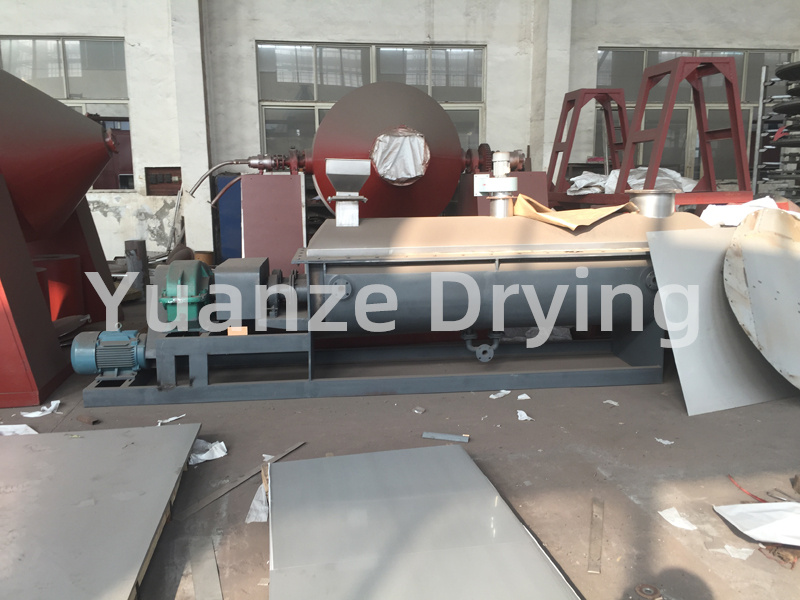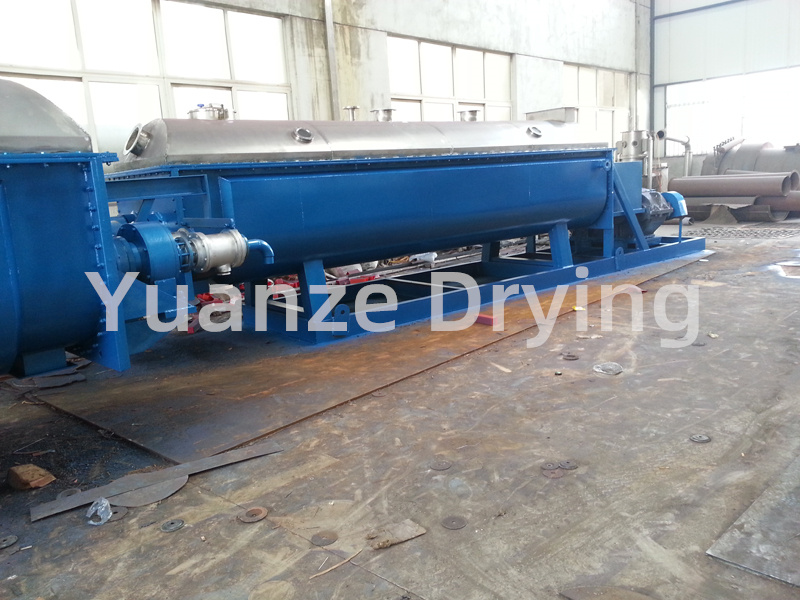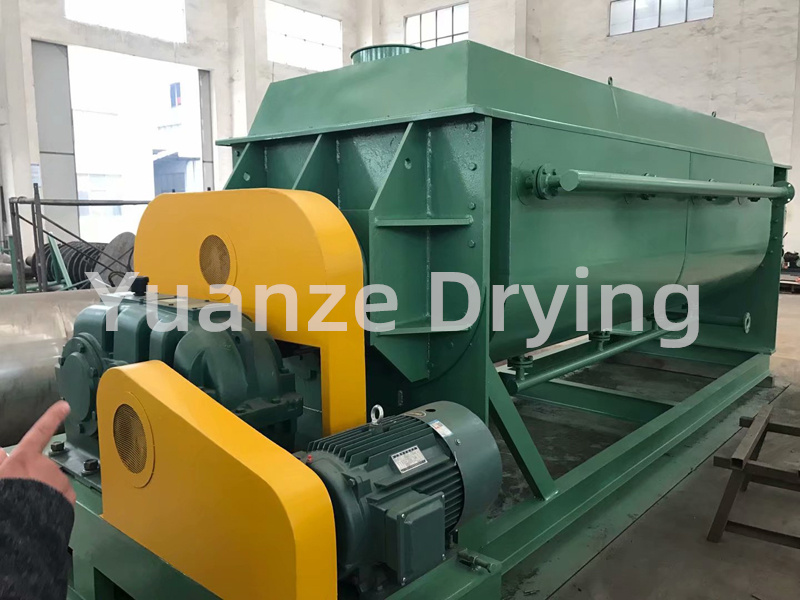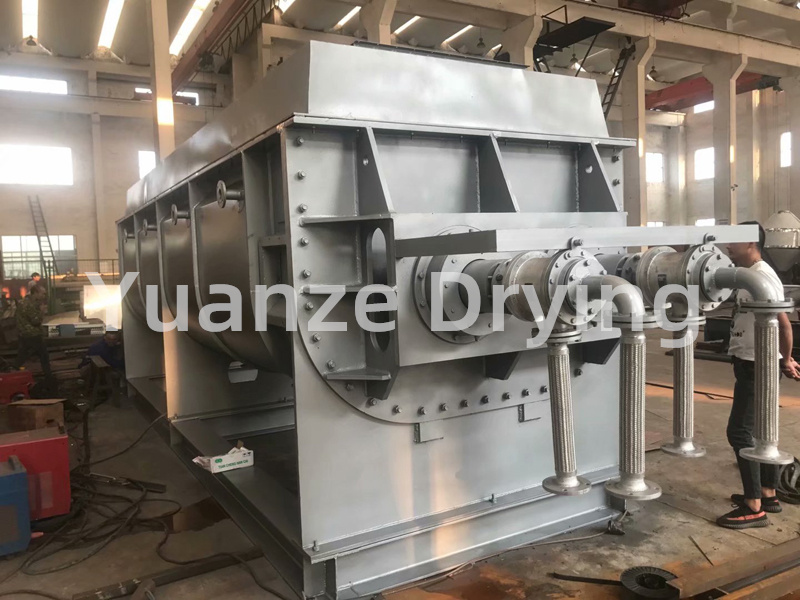Category

Contact person: Zhang Xingqian 13912340688
Phone: 0519-81182602
Fax: 0519-81182602
whatsapp:+8618961131360
Website: glgresearch.com.cn
Email: yz@yzdryer.com steven@yzdryer.com
JYG series hollow blade dryer



JYG series hollow blade dryer
Description
This product can indirectly heat or cool paste, granular, powder, and slurry materials, and can complete unit operations such as drying, cooling, heating, sterilization, reaction, and low-temperature combustion. The special wedge-shaped stirring heat transfer blade in the equipment has high heat transfer efficiency and self-cleaning function of the heat transfer surface.
Wedge shaped hollow blades are densely arranged on the hollow shaft, and the hot medium flows through the blades through the hollow shaft. The heat transfer area per unit effective volume is large, and the temperature of the thermal medium ranges from -40 ℃ to 320 ℃. It can be steam or liquid, such as hot water, thermal oil, etc. Indirect conduction heating does not carry air away heat, and the heat is used to heat the material. The heat loss is only the heat dissipation to the environment through the insulation layer of the device. The wedge-shaped blade heat transfer surface has self-cleaning function. The relative motion between material particles and the wedge surface generates a cleaning effect, which can wash away the attached materials on the wedge surface and maintain a clean heat transfer surface during operation. The shell of the blade dryer is Ω type, and generally two to four hollow mixing shafts are arranged inside the shell. The shell has a sealed end cover and an upper cover to prevent material dust from leaking out and fully play its role.
The heat transfer medium flows through the shell jacket and the hollow stirring shaft through a rotating joint. The hollow stirring shaft has different internal structures according to the type of heat medium to ensure heat transfer efficiency.
Low energy consumption of the slurry dryer: due to indirect heating, there is no large amount of air carried away to carry away heat. The outer wall of the dryer is also equipped with an insulation layer, which only requires 1.2kg of water vapor to evaporate 1kg of water for the slurry material.
The cost of the blade dryer system is low: it has a huge heat transfer surface per unit effective volume, which shortens processing time and reduces equipment size. This greatly reduces the building area and space.
◎ Wide range of material processing: using different thermal media, it can handle both thermosensitive materials and materials that require high-temperature treatment. Common media include steam, heat transfer oil, hot water, cooling water, etc. It can be operated continuously or intermittently and can be applied in many fields.
◎ Low environmental pollution: Do not use carrying air, and carry very little dust and materials. The solvent evaporation of the material is very small, making it easy to handle. For contaminated materials or operating conditions that require solvent recovery, closed-loop circulation can be used.
Low operating costs: low wear and tear, low maintenance costs.
◎ Stable operation: Due to the special compression expansion stirring effect of the wedge-shaped blade, the material particles are fully in contact with the heat transfer surface. Within the axial range, the temperature, humidity, and mixing gradient of the material are very small, ensuring the stability of the process.
The pulp dryer has been successfully used in fields such as food, chemical, petrochemical, dye, and industrial sludge. The characteristics of heat transfer, cooling, and stirring of the equipment enable it to complete the following unit operations: combustion (low temperature), cooling, drying (solvent recovery), heating (melting), reaction, and sterilization. The mixing blade is also a heat transfer surface, which increases the heat transfer area per unit effective volume and shortens the processing time. The wedge-shaped blade heat transfer surface also has self-cleaning function. The compression expansion mixing function ensures even mixing of materials. The material moves in a piston flow along the axial direction, and within the axial range, the temperature, humidity, and mixing gradient of the material are very small. The use of thermal oil as a thermal medium in a slurry dryer can complete low-temperature combustion work. For example, calcium sulfate dihydrate (Ca2SO4 · 2H2O) is burned and converted into calcium sulfate dihydrate (Ca2SO4 · 1/22H2O). Sodium bicarbonate (NaHCO3) is transformed into pure alkali (Na2HCO3) through calcination. Cooling media such as water and cooling salt water can be introduced for cooling. For example, the slurry type alkali cooler used in the soda ash industry replaces the old air cooled alkali cooler, saving energy and exhaust gas treatment equipment, and reducing operating costs. Drying, the main function of the equipment, does not use hot air, making solvent recovery, energy consumption, and environmental control in an ideal state that is easy to handle. It is particularly suitable for solvents that need to be recycled, as well as for flammable, easily oxidizable, and heat sensitive materials. It has been widely used in the fine chemical, petrochemical, and dye industries. The uniformity of temperature, humidity, and mixing degree within the axial range allows the equipment to be used for heating or melting, or for some solid material reactions. It has been successfully used in the compound fertilizer and modified starch industries. The pulp dryer can be used to sterilize food and flour. The large heating area per unit effective volume quickly heats the material to the sterilization temperature, avoiding prolonged heating that may alter the quality of the material.
project model | JYG3 | JYG9 | JYG13 | JYG18 | JYG29 | JYG41 | JYG52 | JYG68 | JYG81 | JYG95 | JYG110 |
| heat transfer area (m2) | 3 | 9 | 13 | 18 | 29 | 41 | 52 | 68 | 81 | 95 | 110 |
| Effective volume (m3) | 0.06 | 0.32 | 0.59 | 1.09 | 1.85 | 2.8 | 3.96 | 5.21 | 6.43 | 8.07 | 9.46 |
| speed range (rmp) | 15-30 | 10-25 | 10-25 | 10-20 | 10-20 | 10-20 | 10-20 | 10-20 | 5-15 | 5-15 | 5-10 |
| power (kw) | 2.2 | 4 | 5.5 | 7.5 | 11 | 15 | 30 | 45 | 55 | 75 | 95 |
| Body width A(mm) | 306 | 584 | 762 | 940 | 1118 | 1296 | 1476 | 1652 | 1828 | 2032 | 2210 |
| Width B(mm) | 736 | 841 | 1066 | 1320 | 1474 | 1676 | 1854 | 2134 | 1186 | 2438 | 2668 |
| Body width C(mm) | 1956 | 2820 | 3048 | 3328 | 4114 | 4724 | 5258 | 5842 | 6020 | 6124 | 6122 |
| Total length D(mm) | 2972 | 4876 | 5486 | 5918 | 6808 | 7570 | 8306 | 9296 | 9678 | 9704 | 9880 |
| Incoming and outgoing distance E(mm) | 1752 | 2540 | 2768 | 3048 | 3810 | 4420 | 4954 | 5384 | 5562 | 5664 | 5664 |
| center height F(mm) | 380 | 380 | 534 | 610 | 762 | 915 | 1066 | 1220 | 1220 | 1220 | 1220 |
| center height H(mm) | 762 | 838 | 1092 | 1270 | 1524 | 1778 | 2032 | 2362 | 2464 | 2566 | 2668 |
| steam inlet N | 3/4 | 3/4 | 1 | 1 | 1 | 1 | 11/2 | 11/2 | 11/2 | 11/2 | 2 |
| delivery port O | 3/4 | 3/4 | 1 | 1 | 1 | 1 | 11/2 | 11/2 | 11/2 | 11/2 | 2 |






